Projects Negotiation and Conflict Report for Queensland Health Payroll Program
VerifiedAdded on 2023/06/15
|7
|1949
|69
AI Summary
This report discusses the negotiation and conflict resolution strategies for the Queensland Health Payroll Program. It includes details about the four projects, participants, negotiation interaction process, negotiation methods, and outcomes.
Contribute Materials
Your contribution can guide someone’s learning journey. Share your
documents today.
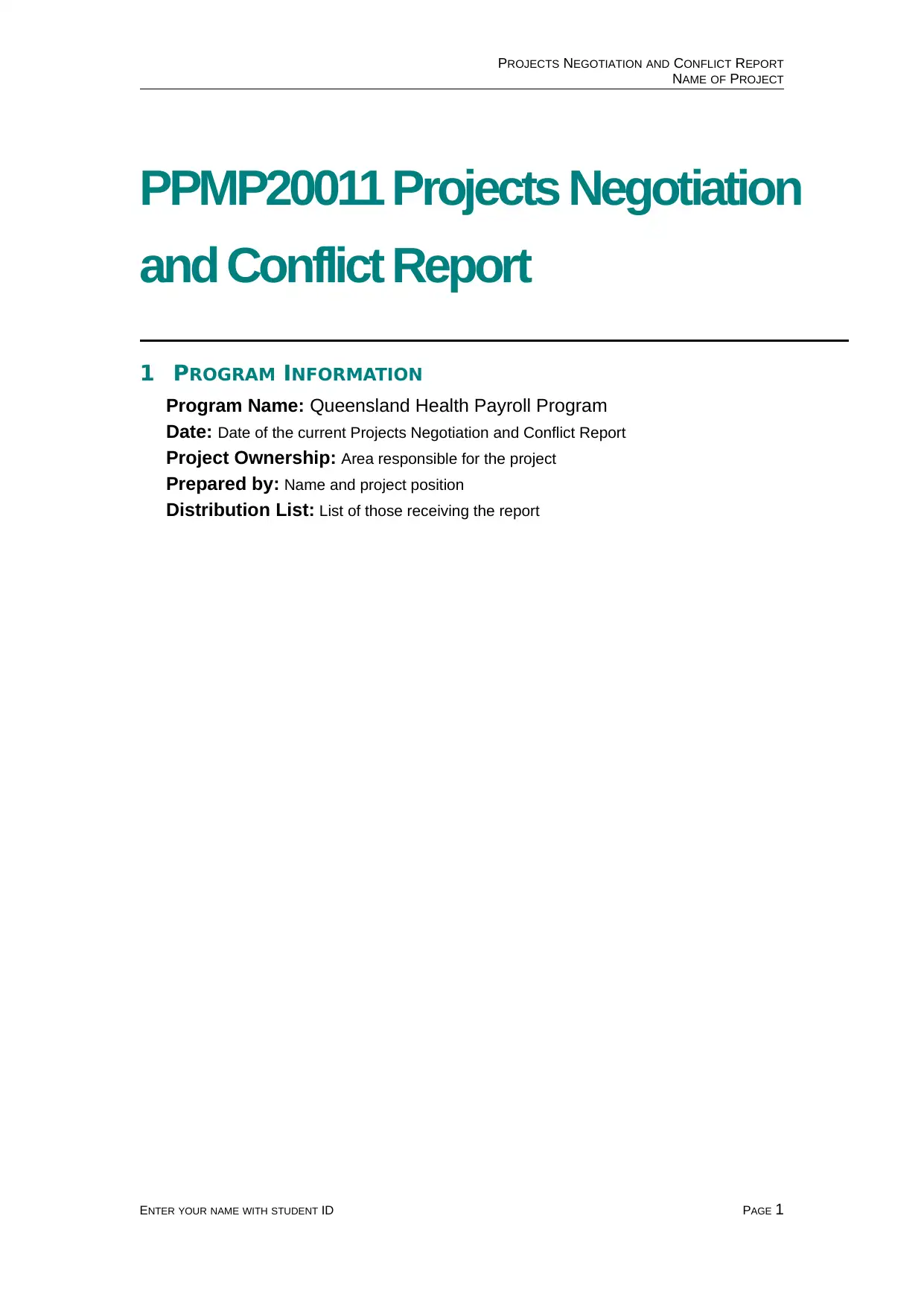
PROJECTS NEGOTIATION AND CONFLICT REPORT
NAME OF PROJECT
PPMP20011 Projects Negotiation
and Conflict Report
1 PROGRAM INFORMATION
Program Name: Queensland Health Payroll Program
Date: Date of the current Projects Negotiation and Conflict Report
Project Ownership: Area responsible for the project
Prepared by: Name and project position
Distribution List: List of those receiving the report
ENTER YOUR NAME WITH STUDENT ID PAGE 1
NAME OF PROJECT
PPMP20011 Projects Negotiation
and Conflict Report
1 PROGRAM INFORMATION
Program Name: Queensland Health Payroll Program
Date: Date of the current Projects Negotiation and Conflict Report
Project Ownership: Area responsible for the project
Prepared by: Name and project position
Distribution List: List of those receiving the report
ENTER YOUR NAME WITH STUDENT ID PAGE 1
Secure Best Marks with AI Grader
Need help grading? Try our AI Grader for instant feedback on your assignments.
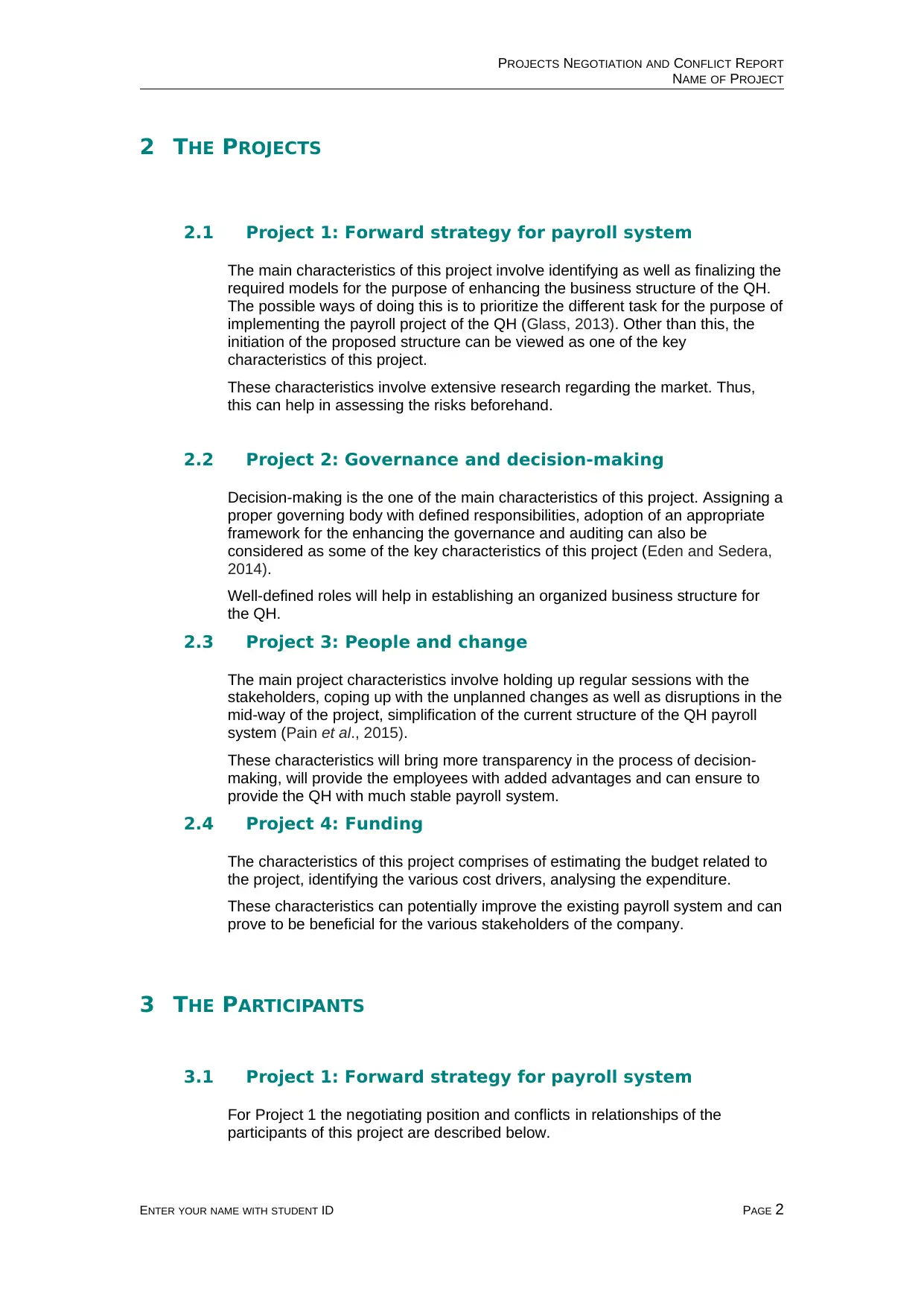
PROJECTS NEGOTIATION AND CONFLICT REPORT
NAME OF PROJECT
2 THE PROJECTS
2.1 Project 1: Forward strategy for payroll system
The main characteristics of this project involve identifying as well as finalizing the
required models for the purpose of enhancing the business structure of the QH.
The possible ways of doing this is to prioritize the different task for the purpose of
implementing the payroll project of the QH (Glass, 2013). Other than this, the
initiation of the proposed structure can be viewed as one of the key
characteristics of this project.
These characteristics involve extensive research regarding the market. Thus,
this can help in assessing the risks beforehand.
2.2 Project 2: Governance and decision-making
Decision-making is the one of the main characteristics of this project. Assigning a
proper governing body with defined responsibilities, adoption of an appropriate
framework for the enhancing the governance and auditing can also be
considered as some of the key characteristics of this project (Eden and Sedera,
2014).
Well-defined roles will help in establishing an organized business structure for
the QH.
2.3 Project 3: People and change
The main project characteristics involve holding up regular sessions with the
stakeholders, coping up with the unplanned changes as well as disruptions in the
mid-way of the project, simplification of the current structure of the QH payroll
system (Pain et al., 2015).
These characteristics will bring more transparency in the process of decision-
making, will provide the employees with added advantages and can ensure to
provide the QH with much stable payroll system.
2.4 Project 4: Funding
The characteristics of this project comprises of estimating the budget related to
the project, identifying the various cost drivers, analysing the expenditure.
These characteristics can potentially improve the existing payroll system and can
prove to be beneficial for the various stakeholders of the company.
3 THE PARTICIPANTS
3.1 Project 1: Forward strategy for payroll system
For Project 1 the negotiating position and conflicts in relationships of the
participants of this project are described below.
ENTER YOUR NAME WITH STUDENT ID PAGE 2
NAME OF PROJECT
2 THE PROJECTS
2.1 Project 1: Forward strategy for payroll system
The main characteristics of this project involve identifying as well as finalizing the
required models for the purpose of enhancing the business structure of the QH.
The possible ways of doing this is to prioritize the different task for the purpose of
implementing the payroll project of the QH (Glass, 2013). Other than this, the
initiation of the proposed structure can be viewed as one of the key
characteristics of this project.
These characteristics involve extensive research regarding the market. Thus,
this can help in assessing the risks beforehand.
2.2 Project 2: Governance and decision-making
Decision-making is the one of the main characteristics of this project. Assigning a
proper governing body with defined responsibilities, adoption of an appropriate
framework for the enhancing the governance and auditing can also be
considered as some of the key characteristics of this project (Eden and Sedera,
2014).
Well-defined roles will help in establishing an organized business structure for
the QH.
2.3 Project 3: People and change
The main project characteristics involve holding up regular sessions with the
stakeholders, coping up with the unplanned changes as well as disruptions in the
mid-way of the project, simplification of the current structure of the QH payroll
system (Pain et al., 2015).
These characteristics will bring more transparency in the process of decision-
making, will provide the employees with added advantages and can ensure to
provide the QH with much stable payroll system.
2.4 Project 4: Funding
The characteristics of this project comprises of estimating the budget related to
the project, identifying the various cost drivers, analysing the expenditure.
These characteristics can potentially improve the existing payroll system and can
prove to be beneficial for the various stakeholders of the company.
3 THE PARTICIPANTS
3.1 Project 1: Forward strategy for payroll system
For Project 1 the negotiating position and conflicts in relationships of the
participants of this project are described below.
ENTER YOUR NAME WITH STUDENT ID PAGE 2
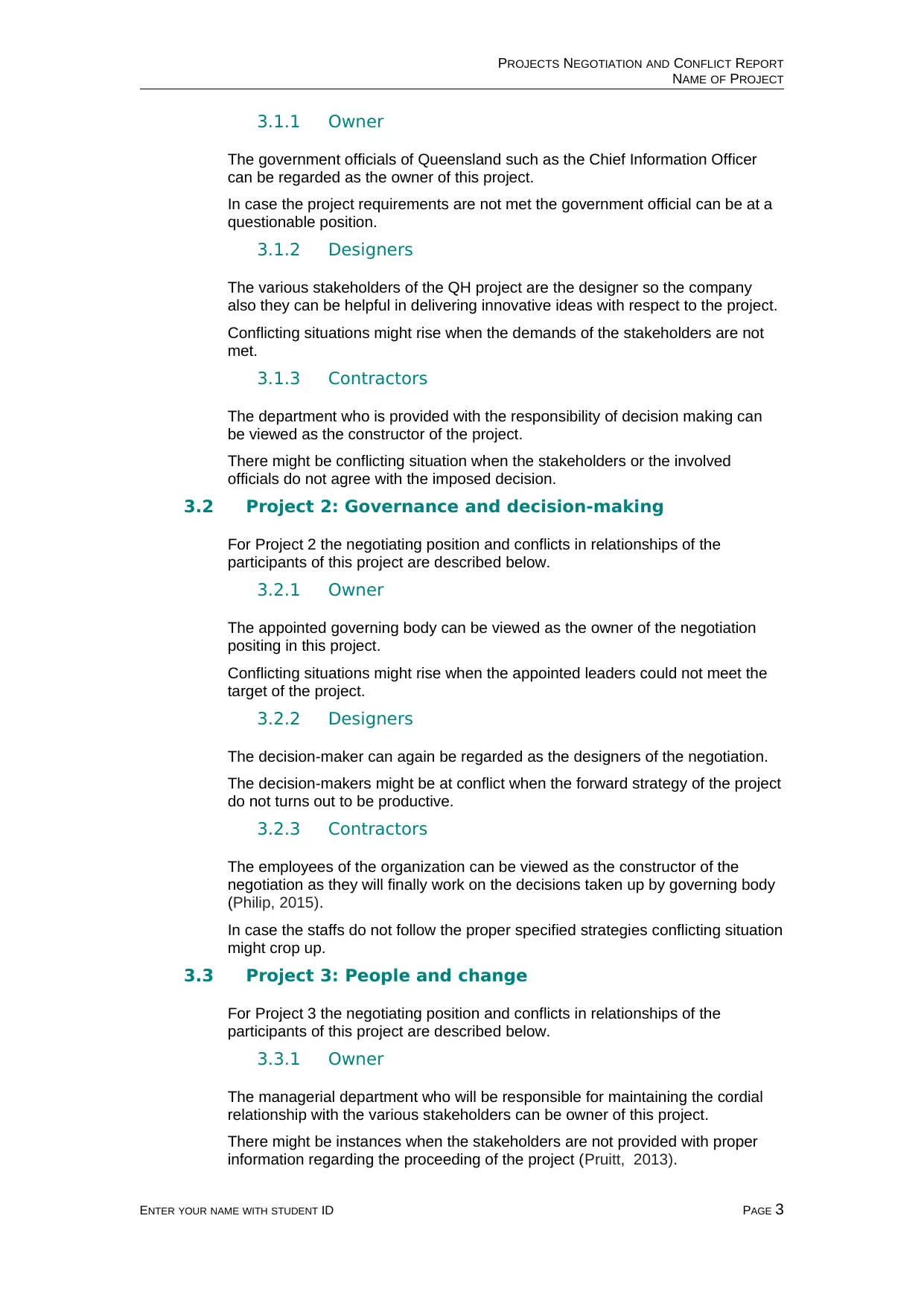
PROJECTS NEGOTIATION AND CONFLICT REPORT
NAME OF PROJECT
3.1.1 Owner
The government officials of Queensland such as the Chief Information Officer
can be regarded as the owner of this project.
In case the project requirements are not met the government official can be at a
questionable position.
3.1.2 Designers
The various stakeholders of the QH project are the designer so the company
also they can be helpful in delivering innovative ideas with respect to the project.
Conflicting situations might rise when the demands of the stakeholders are not
met.
3.1.3 Contractors
The department who is provided with the responsibility of decision making can
be viewed as the constructor of the project.
There might be conflicting situation when the stakeholders or the involved
officials do not agree with the imposed decision.
3.2 Project 2: Governance and decision-making
For Project 2 the negotiating position and conflicts in relationships of the
participants of this project are described below.
3.2.1 Owner
The appointed governing body can be viewed as the owner of the negotiation
positing in this project.
Conflicting situations might rise when the appointed leaders could not meet the
target of the project.
3.2.2 Designers
The decision-maker can again be regarded as the designers of the negotiation.
The decision-makers might be at conflict when the forward strategy of the project
do not turns out to be productive.
3.2.3 Contractors
The employees of the organization can be viewed as the constructor of the
negotiation as they will finally work on the decisions taken up by governing body
(Philip, 2015).
In case the staffs do not follow the proper specified strategies conflicting situation
might crop up.
3.3 Project 3: People and change
For Project 3 the negotiating position and conflicts in relationships of the
participants of this project are described below.
3.3.1 Owner
The managerial department who will be responsible for maintaining the cordial
relationship with the various stakeholders can be owner of this project.
There might be instances when the stakeholders are not provided with proper
information regarding the proceeding of the project (Pruitt, 2013).
ENTER YOUR NAME WITH STUDENT ID PAGE 3
NAME OF PROJECT
3.1.1 Owner
The government officials of Queensland such as the Chief Information Officer
can be regarded as the owner of this project.
In case the project requirements are not met the government official can be at a
questionable position.
3.1.2 Designers
The various stakeholders of the QH project are the designer so the company
also they can be helpful in delivering innovative ideas with respect to the project.
Conflicting situations might rise when the demands of the stakeholders are not
met.
3.1.3 Contractors
The department who is provided with the responsibility of decision making can
be viewed as the constructor of the project.
There might be conflicting situation when the stakeholders or the involved
officials do not agree with the imposed decision.
3.2 Project 2: Governance and decision-making
For Project 2 the negotiating position and conflicts in relationships of the
participants of this project are described below.
3.2.1 Owner
The appointed governing body can be viewed as the owner of the negotiation
positing in this project.
Conflicting situations might rise when the appointed leaders could not meet the
target of the project.
3.2.2 Designers
The decision-maker can again be regarded as the designers of the negotiation.
The decision-makers might be at conflict when the forward strategy of the project
do not turns out to be productive.
3.2.3 Contractors
The employees of the organization can be viewed as the constructor of the
negotiation as they will finally work on the decisions taken up by governing body
(Philip, 2015).
In case the staffs do not follow the proper specified strategies conflicting situation
might crop up.
3.3 Project 3: People and change
For Project 3 the negotiating position and conflicts in relationships of the
participants of this project are described below.
3.3.1 Owner
The managerial department who will be responsible for maintaining the cordial
relationship with the various stakeholders can be owner of this project.
There might be instances when the stakeholders are not provided with proper
information regarding the proceeding of the project (Pruitt, 2013).
ENTER YOUR NAME WITH STUDENT ID PAGE 3

PROJECTS NEGOTIATION AND CONFLICT REPORT
NAME OF PROJECT
3.3.2 Designers
The designers will be the various stakeholders of the QH as their views will
shape the proceedings of the project.
The possible conflicting situation progress of the project does not go in
accordance with the stakeholders’ requirements.
3.3.3 Contractors
The management team who would handle the disruption in the ongoing project
can be regarded as the contractor of negotiation with respect to this project.
The team could be in a situation of conflict when the in case project delays or
disruptions.
3.4 Project 4: Funding
For Project 4 the negotiating position and conflicts in relationships of the
participants of this project are described below.
3.4.1 Owner
The finance team for the QH project can be the owner of the negotiation in this
case.
Over budget of the project can lead to a situation of conflict.
3.4.2 Designers
Designers of the negotiation will be the stakeholders, as their response is of
utmost importance for the making key changes in the project.
In case the expenditure of the project is not calculated properly conflicting
situation might crop up (Rahim, 2017).
3.4.3 Contractors
The employees of the organization are the contractors of the negation as they
will be working on the all the estimated budgets.
The staffs can be at a position of conflict if they could not complete the work
within the estimated budget.
4 THE NEGOTIATION INTERACTION PROCESS
4.1 Project 1: Forward strategy for payroll system
The structural approach of negotiation can be adopted for this project. This
strategy can be helpful in developing a more organized business structure for the
QH. This approach is of utmost importance for the maintaining the different
sectors of QH in well-structured manner (Cahn and Abigail, 2014).
4.2 Project 2: Governance and decision-making
Considering this project, strategic approach can be instrumental in improving the
existing payroll system of the QH as this would be helpful in assessing the risks
beforehand.
ENTER YOUR NAME WITH STUDENT ID PAGE 4
NAME OF PROJECT
3.3.2 Designers
The designers will be the various stakeholders of the QH as their views will
shape the proceedings of the project.
The possible conflicting situation progress of the project does not go in
accordance with the stakeholders’ requirements.
3.3.3 Contractors
The management team who would handle the disruption in the ongoing project
can be regarded as the contractor of negotiation with respect to this project.
The team could be in a situation of conflict when the in case project delays or
disruptions.
3.4 Project 4: Funding
For Project 4 the negotiating position and conflicts in relationships of the
participants of this project are described below.
3.4.1 Owner
The finance team for the QH project can be the owner of the negotiation in this
case.
Over budget of the project can lead to a situation of conflict.
3.4.2 Designers
Designers of the negotiation will be the stakeholders, as their response is of
utmost importance for the making key changes in the project.
In case the expenditure of the project is not calculated properly conflicting
situation might crop up (Rahim, 2017).
3.4.3 Contractors
The employees of the organization are the contractors of the negation as they
will be working on the all the estimated budgets.
The staffs can be at a position of conflict if they could not complete the work
within the estimated budget.
4 THE NEGOTIATION INTERACTION PROCESS
4.1 Project 1: Forward strategy for payroll system
The structural approach of negotiation can be adopted for this project. This
strategy can be helpful in developing a more organized business structure for the
QH. This approach is of utmost importance for the maintaining the different
sectors of QH in well-structured manner (Cahn and Abigail, 2014).
4.2 Project 2: Governance and decision-making
Considering this project, strategic approach can be instrumental in improving the
existing payroll system of the QH as this would be helpful in assessing the risks
beforehand.
ENTER YOUR NAME WITH STUDENT ID PAGE 4
Secure Best Marks with AI Grader
Need help grading? Try our AI Grader for instant feedback on your assignments.
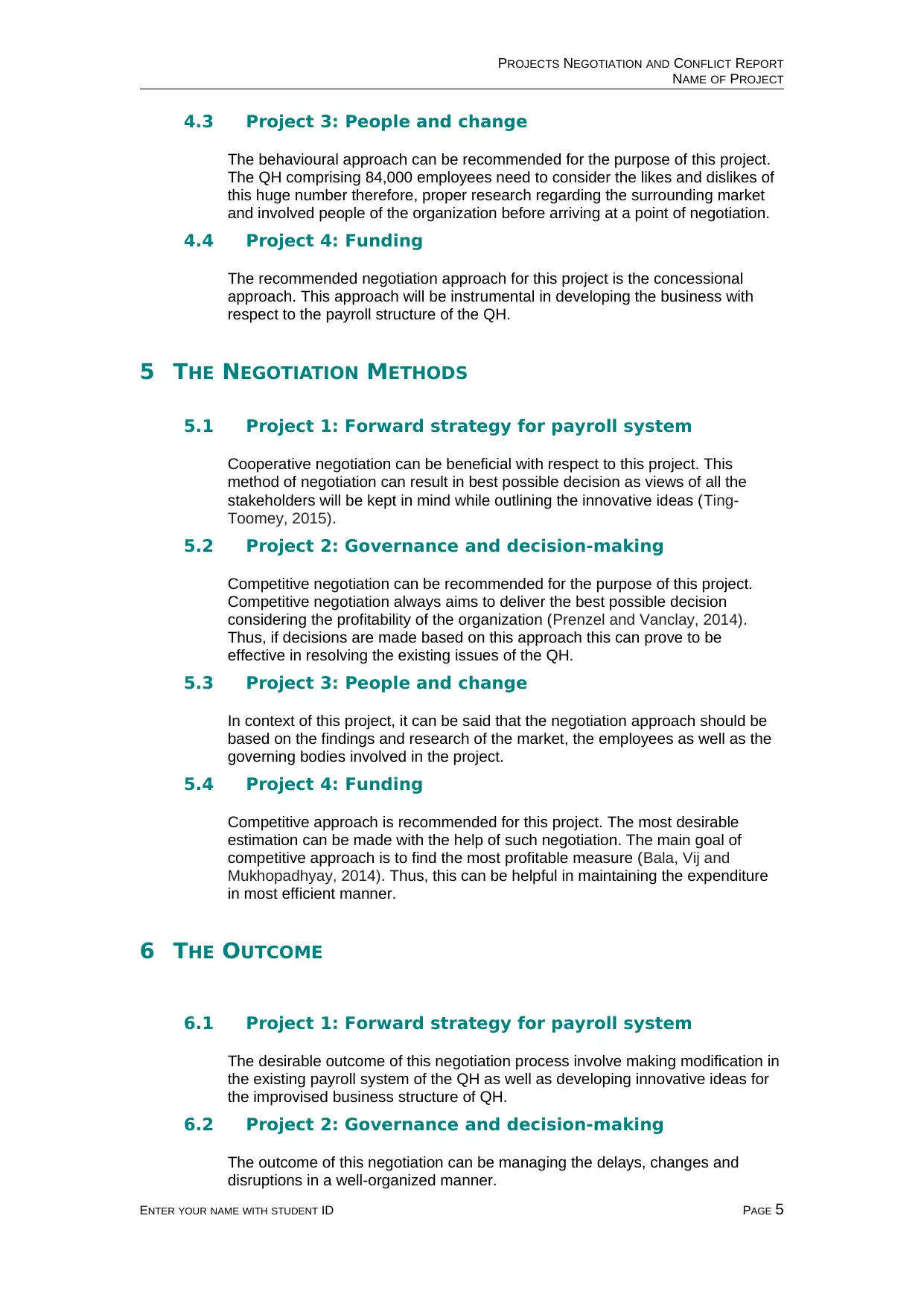
PROJECTS NEGOTIATION AND CONFLICT REPORT
NAME OF PROJECT
4.3 Project 3: People and change
The behavioural approach can be recommended for the purpose of this project.
The QH comprising 84,000 employees need to consider the likes and dislikes of
this huge number therefore, proper research regarding the surrounding market
and involved people of the organization before arriving at a point of negotiation.
4.4 Project 4: Funding
The recommended negotiation approach for this project is the concessional
approach. This approach will be instrumental in developing the business with
respect to the payroll structure of the QH.
5 THE NEGOTIATION METHODS
5.1 Project 1: Forward strategy for payroll system
Cooperative negotiation can be beneficial with respect to this project. This
method of negotiation can result in best possible decision as views of all the
stakeholders will be kept in mind while outlining the innovative ideas (Ting‐
Toomey, 2015).
5.2 Project 2: Governance and decision-making
Competitive negotiation can be recommended for the purpose of this project.
Competitive negotiation always aims to deliver the best possible decision
considering the profitability of the organization (Prenzel and Vanclay, 2014).
Thus, if decisions are made based on this approach this can prove to be
effective in resolving the existing issues of the QH.
5.3 Project 3: People and change
In context of this project, it can be said that the negotiation approach should be
based on the findings and research of the market, the employees as well as the
governing bodies involved in the project.
5.4 Project 4: Funding
Competitive approach is recommended for this project. The most desirable
estimation can be made with the help of such negotiation. The main goal of
competitive approach is to find the most profitable measure (Bala, Vij and
Mukhopadhyay, 2014). Thus, this can be helpful in maintaining the expenditure
in most efficient manner.
6 THE OUTCOME
6.1 Project 1: Forward strategy for payroll system
The desirable outcome of this negotiation process involve making modification in
the existing payroll system of the QH as well as developing innovative ideas for
the improvised business structure of QH.
6.2 Project 2: Governance and decision-making
The outcome of this negotiation can be managing the delays, changes and
disruptions in a well-organized manner.
ENTER YOUR NAME WITH STUDENT ID PAGE 5
NAME OF PROJECT
4.3 Project 3: People and change
The behavioural approach can be recommended for the purpose of this project.
The QH comprising 84,000 employees need to consider the likes and dislikes of
this huge number therefore, proper research regarding the surrounding market
and involved people of the organization before arriving at a point of negotiation.
4.4 Project 4: Funding
The recommended negotiation approach for this project is the concessional
approach. This approach will be instrumental in developing the business with
respect to the payroll structure of the QH.
5 THE NEGOTIATION METHODS
5.1 Project 1: Forward strategy for payroll system
Cooperative negotiation can be beneficial with respect to this project. This
method of negotiation can result in best possible decision as views of all the
stakeholders will be kept in mind while outlining the innovative ideas (Ting‐
Toomey, 2015).
5.2 Project 2: Governance and decision-making
Competitive negotiation can be recommended for the purpose of this project.
Competitive negotiation always aims to deliver the best possible decision
considering the profitability of the organization (Prenzel and Vanclay, 2014).
Thus, if decisions are made based on this approach this can prove to be
effective in resolving the existing issues of the QH.
5.3 Project 3: People and change
In context of this project, it can be said that the negotiation approach should be
based on the findings and research of the market, the employees as well as the
governing bodies involved in the project.
5.4 Project 4: Funding
Competitive approach is recommended for this project. The most desirable
estimation can be made with the help of such negotiation. The main goal of
competitive approach is to find the most profitable measure (Bala, Vij and
Mukhopadhyay, 2014). Thus, this can be helpful in maintaining the expenditure
in most efficient manner.
6 THE OUTCOME
6.1 Project 1: Forward strategy for payroll system
The desirable outcome of this negotiation process involve making modification in
the existing payroll system of the QH as well as developing innovative ideas for
the improvised business structure of QH.
6.2 Project 2: Governance and decision-making
The outcome of this negotiation can be managing the delays, changes and
disruptions in a well-organized manner.
ENTER YOUR NAME WITH STUDENT ID PAGE 5

PROJECTS NEGOTIATION AND CONFLICT REPORT
NAME OF PROJECT
6.3 Project 3: People and change
Maintaining healthy relationship with the various stakeholders can be desired
outcome.
6.4 Project 4: Funding
The outcome of this negotiation will mainly involve enhancing the profitability of
the organization.
ENTER YOUR NAME WITH STUDENT ID PAGE 6
NAME OF PROJECT
6.3 Project 3: People and change
Maintaining healthy relationship with the various stakeholders can be desired
outcome.
6.4 Project 4: Funding
The outcome of this negotiation will mainly involve enhancing the profitability of
the organization.
ENTER YOUR NAME WITH STUDENT ID PAGE 6
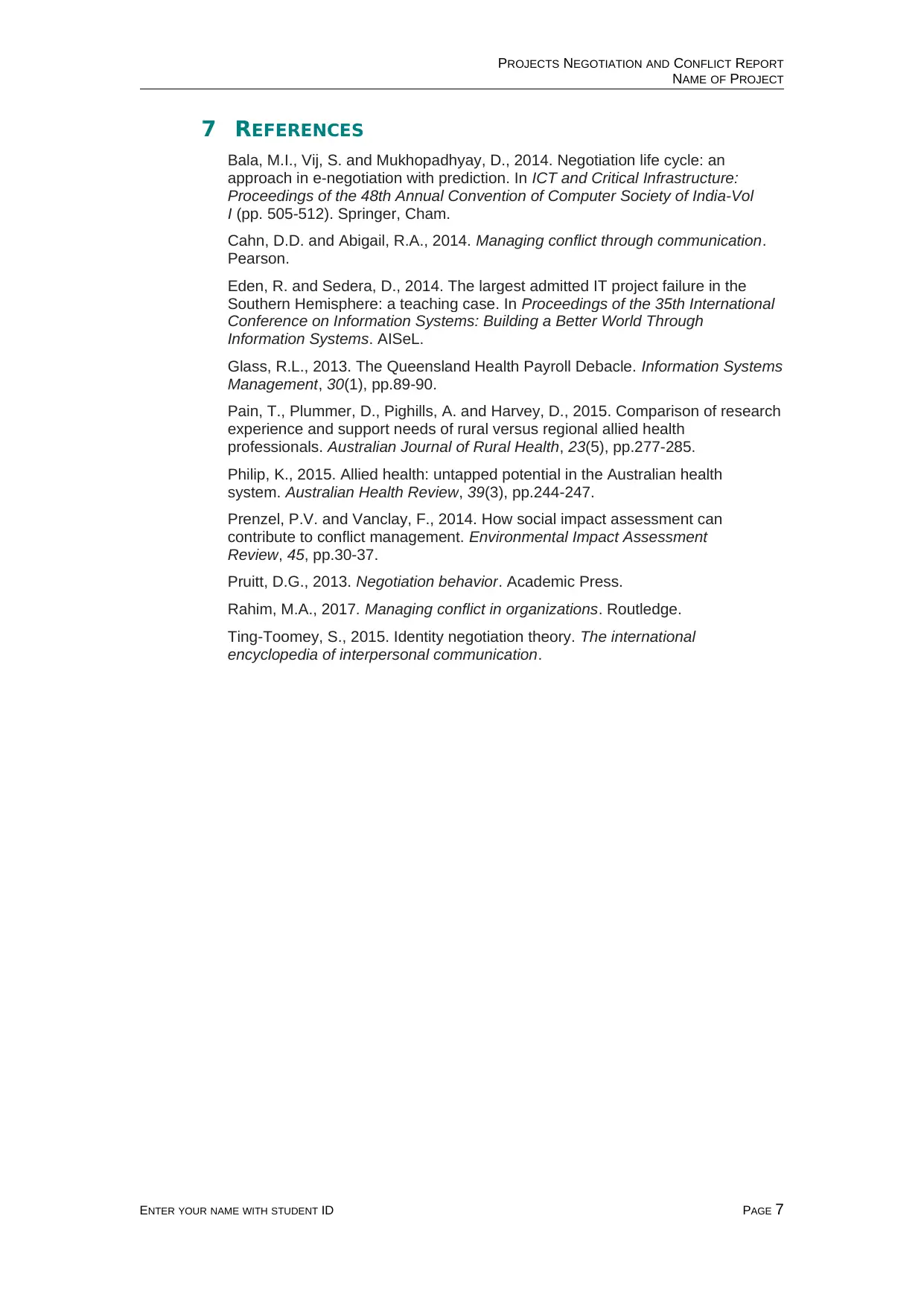
PROJECTS NEGOTIATION AND CONFLICT REPORT
NAME OF PROJECT
7 REFERENCES
Bala, M.I., Vij, S. and Mukhopadhyay, D., 2014. Negotiation life cycle: an
approach in e-negotiation with prediction. In ICT and Critical Infrastructure:
Proceedings of the 48th Annual Convention of Computer Society of India-Vol
I (pp. 505-512). Springer, Cham.
Cahn, D.D. and Abigail, R.A., 2014. Managing conflict through communication.
Pearson.
Eden, R. and Sedera, D., 2014. The largest admitted IT project failure in the
Southern Hemisphere: a teaching case. In Proceedings of the 35th International
Conference on Information Systems: Building a Better World Through
Information Systems. AISeL.
Glass, R.L., 2013. The Queensland Health Payroll Debacle. Information Systems
Management, 30(1), pp.89-90.
Pain, T., Plummer, D., Pighills, A. and Harvey, D., 2015. Comparison of research
experience and support needs of rural versus regional allied health
professionals. Australian Journal of Rural Health, 23(5), pp.277-285.
Philip, K., 2015. Allied health: untapped potential in the Australian health
system. Australian Health Review, 39(3), pp.244-247.
Prenzel, P.V. and Vanclay, F., 2014. How social impact assessment can
contribute to conflict management. Environmental Impact Assessment
Review, 45, pp.30-37.
Pruitt, D.G., 2013. Negotiation behavior. Academic Press.
Rahim, M.A., 2017. Managing conflict in organizations. Routledge.
Ting‐Toomey, S., 2015. Identity negotiation theory. The international
encyclopedia of interpersonal communication.
ENTER YOUR NAME WITH STUDENT ID PAGE 7
NAME OF PROJECT
7 REFERENCES
Bala, M.I., Vij, S. and Mukhopadhyay, D., 2014. Negotiation life cycle: an
approach in e-negotiation with prediction. In ICT and Critical Infrastructure:
Proceedings of the 48th Annual Convention of Computer Society of India-Vol
I (pp. 505-512). Springer, Cham.
Cahn, D.D. and Abigail, R.A., 2014. Managing conflict through communication.
Pearson.
Eden, R. and Sedera, D., 2014. The largest admitted IT project failure in the
Southern Hemisphere: a teaching case. In Proceedings of the 35th International
Conference on Information Systems: Building a Better World Through
Information Systems. AISeL.
Glass, R.L., 2013. The Queensland Health Payroll Debacle. Information Systems
Management, 30(1), pp.89-90.
Pain, T., Plummer, D., Pighills, A. and Harvey, D., 2015. Comparison of research
experience and support needs of rural versus regional allied health
professionals. Australian Journal of Rural Health, 23(5), pp.277-285.
Philip, K., 2015. Allied health: untapped potential in the Australian health
system. Australian Health Review, 39(3), pp.244-247.
Prenzel, P.V. and Vanclay, F., 2014. How social impact assessment can
contribute to conflict management. Environmental Impact Assessment
Review, 45, pp.30-37.
Pruitt, D.G., 2013. Negotiation behavior. Academic Press.
Rahim, M.A., 2017. Managing conflict in organizations. Routledge.
Ting‐Toomey, S., 2015. Identity negotiation theory. The international
encyclopedia of interpersonal communication.
ENTER YOUR NAME WITH STUDENT ID PAGE 7
1 out of 7
Related Documents
Your All-in-One AI-Powered Toolkit for Academic Success.
+13062052269
info@desklib.com
Available 24*7 on WhatsApp / Email
![[object Object]](/_next/static/media/star-bottom.7253800d.svg)
Unlock your academic potential
© 2024 | Zucol Services PVT LTD | All rights reserved.

